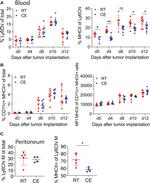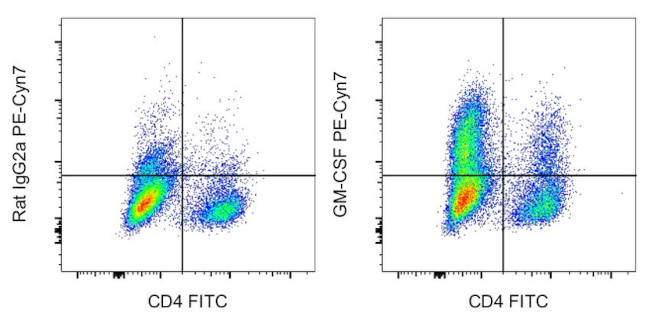Search Thermo Fisher Scientific
Invitrogen
GM-CSF Monoclonal Antibody (MP1-22E9), PE-Cyanine7, eBioscience™
FIGURE: 1 / 2
GM-CSF Antibody (25-7331-82) in Flow


Product Details
25-7331-82
Species Reactivity
Published species
Host/Isotype
Recommended Isotype Control
Class
Type
Clone
Conjugate
Excitation/Emission Max
Form
Concentration
Purification
Storage buffer
Contains
Storage conditions
Shipping conditions
RRID
Product Specific Information
Description: The MP1-22E9 antibody reacts with mouse granulocyte/macrophage - colony stimulating factor (GM-CSF). The MP1-22E9 antibody is a neutralizing antibody. mouse GM-CSF is a 14 kDa factor produced mainly by activated T cells and macrophages. Other cell types, such as endothelium and fibroblasts, also secrete GM-CSF in response to TNF-alpha, IL-2, IL-1, and IFN-gamma. GM-CSF stimulates growth of macrophages, granulocytes and dendritic cells. GM-CSF is found as a membrane-bound form and also as a complex associated with the extracellular matrix. Non-glycosylated GM-CSF is biologically active.
Applications Reported: This MP1-22E9 antibody has been reported for use in intracellular staining followed by flow cytometric analysis.
Applications Tested: This MP1-22E9 antibody has been tested by intracellular staining followed by flow cytometric analysis of restimulated mouse splenocytes. This may be used at less than or equal to 0.25 µg per test. A test is defined as the amount (µg) of antibody that will stain a cell sample in a final volume of 100 µL. Cell number should be determined empirically but can range from 10^5 to 10^8 cells/test. It is recommended that the antibody be carefully titrated for optimal performance in the assay of interest.
Light sensitivity: This tandem dye is sensitive to photo-induced oxidation. Please protect this vial and stained samples from light.
Fixation: Samples can be stored in IC Fixation Buffer (Product # 00-8222-49) (100 µL of cell sample + 100 µL of IC Fixation Buffer) or 1-step Fix/Lyse Solution (Product # 00-5333-57) for up to 3 days in the dark at 4°C with minimal impact on brightness and FRET efficiency/compensation. Some generalizations regarding fluorophore performance after fixation can be made, but clone specific performance should be determined empirically.
Excitation: 488-561 nm; Emission: 775 nm; Laser: Blue Laser, Green Laser, Yellow-Green Laser.
Target Information
The GM-CSF gene encodes for a cytokine that regulates the production, differentiation, and function of macrophages and granulocytes. The active form of the protein exists as a homodimer in the extracellular space. This gene is located in a cluster of related genes at the chromosome region 5q31, which has been associated with interstitial deletions in the 5q- syndrome and acute myelogenous leukemia. Other genes in the cluster include interleukins 4, 5, and 13. The gene is involved in promoting tissue inflammation. Elevated levels of cytokines, including the one produced by this gene, have been observed in SARS-CoV-2 infected patients with acute respiratory distress syndrome. Mice that lack this gene or its receptor have been shown to develop pulmonary alveolar proteinosis.
For Research Use Only. Not for use in diagnostic procedures. Not for resale without express authorization.
How to use the Panel Builder
Watch the video to learn how to use the Invitrogen Flow Cytometry Panel Builder to build your next flow cytometry panel in 5 easy steps.
Bioinformatics
Protein Aliases: Colony-stimulating factor; CSF; GM-CSF; granulocyte macrophage colony stimulating factor; granulocyte-macrophage colony stimulating factor 2; Granulocyte-macrophage colony-stimulating factor; M-GM-CSF; MGC131935; MGC138897; MGC151255; MGC151257; put. GM-CSF
Gene Aliases: Csf2; Csfgm; Gm-CSf; GMCSF; MGI-IGM
UniProt ID: (Mouse) P01587
Entrez Gene ID: (Mouse) 12981

Performance Guarantee
If an Invitrogen™ antibody doesn't perform as described on our website or datasheet,we'll replace the product at no cost to you, or provide you with a credit for a future purchase.*
Learn more
We're here to help
Get expert recommendations for common problems or connect directly with an on staff expert for technical assistance related to applications, equipment and general product use.
Contact tech support

